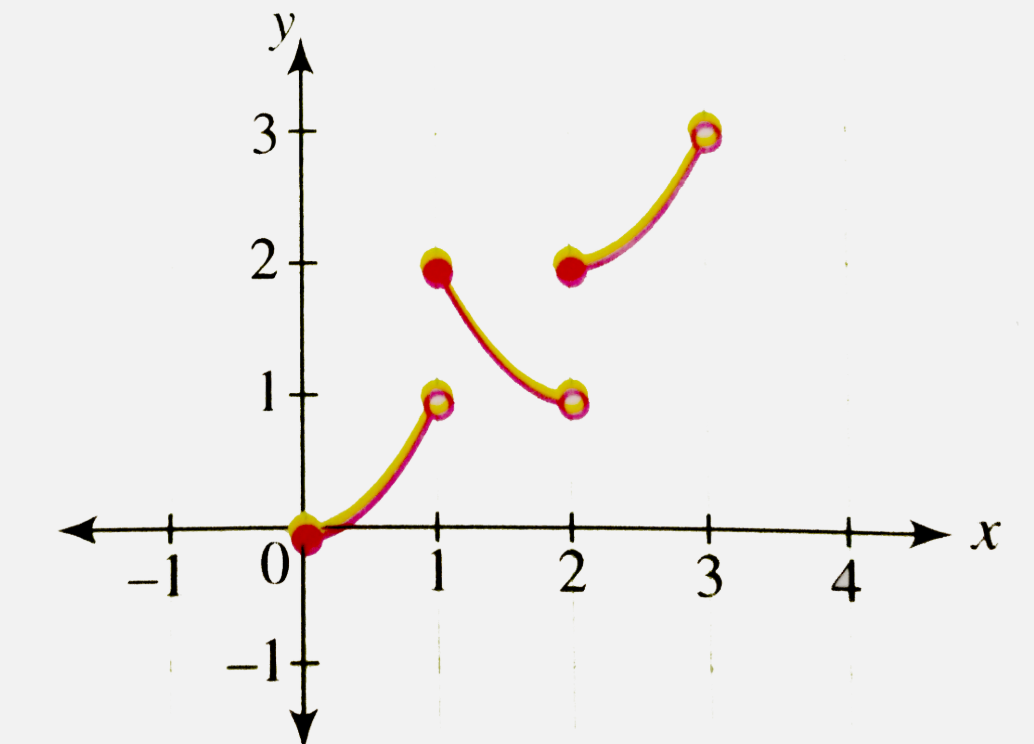Find the sum of the vectors →a=ˆi−2ˆj+ˆk, →b=2ˆi+4ˆj+5ˆk and →c=2ˆi−6ˆj−7ˆkSolution in Tamil

(a) The root of the equation f(x) = 0 occurs where graph y= f(x) meets the x-axis.
From the graph, roots of f(x) = 0 are x =- 1 and x = 2.
(b) The root of the equation f(x) = 4 occurs where the height of the graph is 4.
Hence the roots of f(x) = 0 are x = - 2 and x = 3.
(c) The root of the equation f(x) = 10 occurs where the height of the graph is 10.
Hence the roots of f(x) = 0 are x =- 3 and x =4.
Topper's Solved these Questions
- GETTING STARTED WITH GRAPHSBOOK - CENGAGECHAPTER - GETTING STARTED WITH GRAPHSEXERCISE - Exercise
18 Videos
- FUNCTIONSBOOK - CENGAGECHAPTER - FUNCTIONSEXERCISE - Question Bank
21 Videos
- GRAPH OF INVERSE TRIGONOMETRIC FUNCTIONSBOOK - CENGAGECHAPTER - GRAPH OF INVERSE TRIGONOMETRIC FUNCTIONSEXERCISE - Exercise
18 Videos
Similar Questions
Does the following graph pass the vertical or horizontal line test ?

View SolutionIf there are four distinct real numbers satisfying thẻ equation ∣∣x2−4x−7∣∣=n, then number of integers in the range of n is
View SolutionDraw the graph of y=tan−1x+cot−1x
View SolutionLet →a=ˆj−ˆk and →c=ˆi−ˆj−ˆk . Then vector →b satisfying →a×→b+→c=→0 and →a.→b=3 is (1) 2→i−→j+2→k (2) ˆi−ˆj−2ˆk (3) ˆi+j−2ˆk (4) −ˆi+ˆj−2ˆk
View SolutionFind the volume of the parallelepiped whose coterminous edges are represented by the vectors: →a=2ˆi+3ˆj+4ˆk,→b=ˆi+2ˆj−ˆk,→c=3ˆi−ˆj+2ˆk →a=2ˆi+3ˆj+4ˆk,→b=ˆi+2ˆj−ˆk,→c=3ˆi−ˆj−2ˆk →a=11ˆi,→b=2ˆj−ˆk,→c=13ˆk →a=ˆi+ˆj+ˆk,→b=ˆi−ˆj+ˆk,→c=ˆi+2ˆj−ˆk
View SolutionShow that each of the following triads of vectors are coplanar: →a=ˆi+2ˆj−ˆk,→b=3ˆi+2ˆj+7ˆk,→c=5ˆi−6ˆj+5ˆk →a=−4ˆi−6ˆj−2ˆk,→b=−ˆi+4ˆj+3ˆk,→c=8ˆi−ˆj+3ˆk ˆa=ˆi−2ˆj+3ˆk,→b=−2ˆi+3ˆj−4ˆk,→c=ˆi−3ˆj+5ˆk
View SolutionIf →a=ˆi+ˆj,→b=ˆj+ˆk,→c=ˆk+ˆi, then in the reciprocal system of vectors →a,→b,→c reciprocal →a of vector →a is a.ˆi+ˆj+ˆk2 b. ˆi−ˆj+ˆk2 c. −ˆi−ˆj+ˆk2 d. ˆi+ˆj−ˆk2
View SolutionFind the unit vectors perpendicular to both →a and →b when
(i) →a=3ˆi+ˆj−2ˆk and →b=2ˆi+3ˆj−ˆk
(ii) →a=ˆi−2ˆj+3ˆk and →b=ˆi+2ˆj−ˆk
(iii) →a=ˆi+3ˆj−2ˆk and →b=−ˆi+3ˆk
(iv) →a=4ˆi+2ˆj−ˆk and →b=ˆi+4ˆj−ˆk
View SolutionIf →a=ˆi+ˆj−ˆk,→b=2ˆi−2ˆj+ˆkand→c=3ˆi+2ˆj−2ˆk show that ,
→a.(→b+→c)=→a.→b+→a.→c
View SolutionFind the sum of the vectors
→a=ˆi−2ˆj+ˆk,→b=−2ˆi+4ˆj+5ˆk and →c=ˆi−6ˆj−7ˆk
View SolutionIf →a=ˆi+ˆj+ˆk, →b=2ˆi−ˆj+3ˆk and →c=ˆi−2ˆj+ˆk, find a unit vector parallel to the vector 2→a−→b+3→c
View SolutionIf →a=ˆi+ˆj,→b=ˆj+ˆk,→c=ˆk+ˆi, then in the reciprocal system of vectors →a,→b,→c reciprocal →a of vector →a is a.ˆi+ˆj+ˆk2 b. ˆi−ˆj+ˆk2 c. −ˆi−ˆj+ˆk2 d. ˆi+ˆj−ˆk2
View SolutionFind →a.→b , when (i) →a=ˆi−2ˆj+ˆk and →b=4ˆi−4ˆj+7ˆk (ii)→a= ˆj+2ˆk and →b = 2ˆi+ˆk (iii) →a=ˆj−ˆk and→b= 2ˆi+3ˆj−2ˆk
View SolutionFind the volume of the parallelepiped whose coterminous edges are represented by the vectors: i,→a=2ˆi+3ˆj+4ˆk,→b=ˆi+2ˆj−ˆk,→c=3ˆi−ˆj+2ˆk ii, →a=2ˆi−3ˆj+4ˆk,→b=ˆi+2ˆj−ˆk,→c=3ˆi−ˆj−2ˆk iii, →a=11ˆi,→b=2ˆj,→c=13ˆk iv, →a=ˆi+ˆj+ˆk,→b=ˆi−ˆj+ˆk,→c=ˆi+2ˆj−ˆk
View SolutionShow that each of the following triads of vectors are coplanar: →a=ˆi+2ˆj−ˆk,→b=3ˆi+2ˆj+7ˆk,→c=5ˆi+6ˆj+5ˆk →a=−4ˆi−6ˆj−2ˆk,→b=−ˆi+4ˆj+3ˆk,→c=−8ˆi−ˆj+3ˆk ˆa=ˆi−2ˆj+3ˆk,→b=−2ˆi+3ˆj−4ˆk,→c=ˆi−3ˆj+5ˆk
View Solution
